Molti utenti di WordPress preferiscono lavorare sui propri siti web utilizzando un server locale sul proprio computer. In questo modo è possibile lavorare sul sito web in modo privato prima di rendere disponibili le modifiche on line.
Alla fine, dovrete spostarlo su un server live per renderlo accessibile ai visitatori online. Questa transizione è fondamentale per garantire il corretto funzionamento del sito web on line.
Abbiamo lavorato su molti siti web locali, quindi abbiamo dovuto imparare il modo più semplice per trasferire i contenuti a siti web in carne e ossa.
In questo articolo forniremo istruzioni passo passo su come spostare WordPress da un server locale a un sito live.
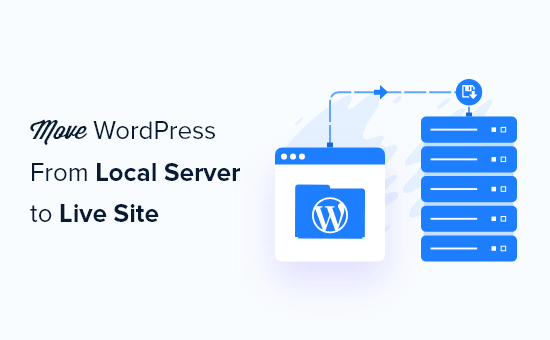
Perché spostare WordPress da un server locale a un sito live?
Creare il vostro blog WordPress su un server locale è un modo sicuro per testare le modifiche apportate al vostro sito web senza influenzare i visitatori.
Una volta perfezionato il sito web, il passo successivo consiste nel passare dal server locale a un sito live.
Vi mostriamo due modi per spostare il vostro sito da un server locale a un sito live.
Il primo metodo utilizza un plugin di migrazione di WordPress ed è consigliato ai principianti.
Nel secondo metodo, vi mostreremo come spostare manualmente WordPress da un server locale a un sito live.
Potete scegliere il metodo più adatto a voi:
Prima di migrare il sito WordPress
Per migrare WordPress da un server locale a un server live è necessario disporre di alcuni elementi.
Innanzitutto, supponiamo che abbiate un sito WordPress in esecuzione su un server locale (chiamato anche localhost) sul vostro computer e che abbiate pieno accesso ad esso.
Successivamente, è necessario disporre di un nome di dominio e di un hosting web.
Abbiamo sentito innumerevoli storie di principianti che hanno iniziato con fornitori di hosting web scadenti o gratuiti e se ne sono pentiti. Secondo la nostra esperienza, la scelta del giusto fornitore di hosting è fondamentale per il successo di qualsiasi sito web.
Per facilitare la vostra decisione, vi consigliamo di utilizzare Bluehost. Si tratta di una società di hosting WordPress ufficialmente raccomandata, che offre agli utenti di WPBeginner uno sconto esclusivo + dominio e SSL gratuiti.
In pratica, potete iniziare a lavorare con soli 1,99 dollari al mese.
Se volete un’ottima alternativa a Bluehost, potete dare un’occhiata a Hostinger. Offre anche uno sconto esclusivo agli utenti di WPBeginner con un nome di dominio gratuito.
Se potete permettervi di pagare un po’ di più, allora date un’occhiata a SiteGround. Hanno anche un’offerta speciale per i lettori di WPBeginner.
Se avete bisogno di aiuto per creare il vostro sito web, seguite la nostra guida passo passo su come creare un sito web.
Infine, è necessario disporre di un programma FTP e sapere come usare l’FTP per caricare il sito del server locale sul sito live.
Siete pronti? Iniziamo la migrazione del vostro sito WordPress.
Video tutorial
Se preferite le istruzioni scritte, continuate a leggere.
Metodo 1: Trasferire WordPress dal server locale al sito live utilizzando un plugin di migrazione (consigliato)
Questo metodo è più semplice e consigliato ai principianti. Utilizzeremo un plugin di migrazione di WordPress per spostare WordPress da localhost a un sito live.
Passo 1: Installare e configurare il plugin Duplicator
Per prima cosa, è necessario installare e attivare il plugin Duplicator sul sito locale. Per maggiori dettagli, consultate la nostra guida passo-passo su come installare un plugin di WordPress.
Suggerimento professionale: Esiste anche una versione pro di Duplicator che offre backup sicuri, archiviazione su cloud, ripristino semplice del sito e altro ancora.
Dopo l’attivazione, è necessario andare alla pagina Duplicator ” Backups e fare clic sul pulsante ‘Create New’.
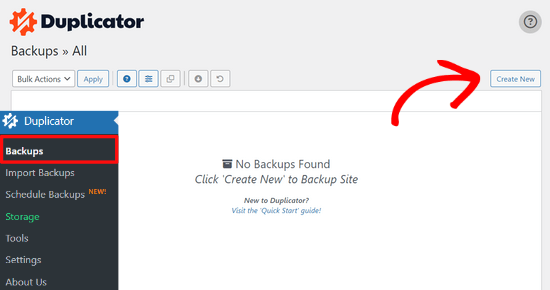
Si accede così a una schermata in cui è possibile assegnare un nome al backup.
Quindi, fare clic sul pulsante “Avanti”.

Duplicator eseguirà ora alcuni test per verificare che tutto sia in ordine.
Se tutti gli elementi sono contrassegnati da “Buono”, cliccate sul pulsante “Costruisci”.

Questo processo può richiedere alcuni minuti, a seconda delle dimensioni del sito web. È necessario lasciare aperta questa scheda fino al completamento.
Una volta terminato, verranno visualizzate le opzioni di download per i pacchetti “Installatore” e “Archivio”. È necessario fare clic sul pulsante “Scarica entrambi i file” per scaricare entrambi i file sul computer.

Il file “Archivio” è una copia completa del vostro sito WordPress. Include tutti i file principali di WordPress, nonché le immagini, i caricamenti, i temi, i plugin e un backup del database di WordPress.
Il file “Installer” è uno script che automatizza l’intero processo di migrazione scompattando il file di archivio contenente il vostro sito web.
Fase 2: Creare un database per il vostro sito web WordPress dal vivo
Prima di eseguire il programma di installazione o di caricare il sito web WordPress da localhost al vostro server di hosting, dovete creare un database MySQL per il vostro nuovo sito web live.
Se avete già creato un database MySQL, potete saltare questo passaggio.
Per creare un database, è necessario visitare la dashboard del cPanel del proprio account di hosting. Quindi, individuate la sezione “Database” e fate clic sull’icona “MySQL Database Wizard”.
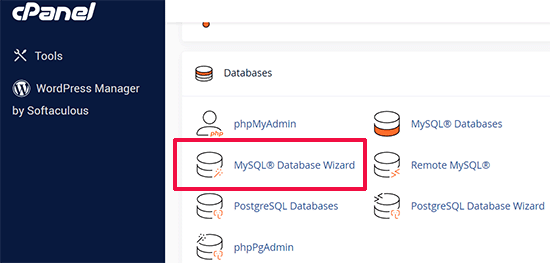
Nella schermata successiva, c’è un campo per creare un nuovo database.
È sufficiente indicare un nome per il database e fare clic sul pulsante “Crea database”.

cPanel creerà ora un nuovo database per voi.
A questo punto, è necessario inserire un nome utente e una password per il nuovo utente e fare clic sul pulsante “Crea utente”.
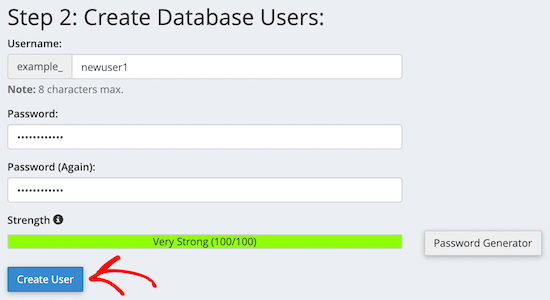
Successivamente, è necessario aggiungere l’utente appena creato al database.
Innanzitutto, fare clic sulla casella di controllo “Tutti i privilegi”.
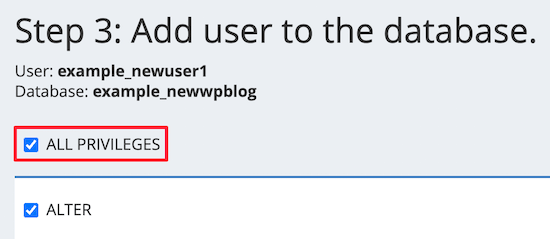
Quindi, scorrere verso il basso e fare clic sul pulsante “Applica modifiche” per salvare le modifiche.
Il database è ora pronto per essere utilizzato con il vostro sito WordPress. Assicuratevi di annotare il nome del database, il nome utente e la password. Queste informazioni vi serviranno nella fase successiva.
Fase 3: caricare i file dal server locale al sito web WordPress dal vivo
Ora è necessario caricare i file dell’archivio e del programma di installazione dal sito locale all’account di hosting.
Per prima cosa, collegatevi al vostro sito live utilizzando un client FTP. Una volta collegati, assicuratevi che la directory principale del vostro sito sia completamente vuota.
Normalmente, la directory principale è la cartella /home/public_html/.
Alcune società di hosting WordPress installano automaticamente WordPress al momento dell’iscrizione. Se sono presenti file di WordPress, è necessario eliminarli.
Successivamente, è possibile caricare i file archive.zip e installer.php da Duplicator nella cartella principale vuota.

Passo 4: esecuzione dello script di migrazione
Dopo aver caricato i file di migrazione, è necessario visitare il seguente URL nel browser:
http://example.com/installer.php
Non dimenticate di sostituire “example.com” con il vostro nome di dominio.
In questo modo si avvia la migrazione guidata di Duplicator.
Il programma di installazione eseguirà alcuni test e inizializzerà lo script.
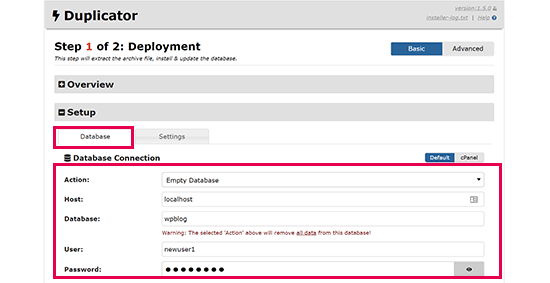
Nella sezione Setup, vi verrà chiesto di inserire l’host MySQL, il nome del database, il nome utente e la password.
L’host sarà probabilmente un host locale. Successivamente, si inseriranno i dettagli del database creato nel passo precedente.
Quindi, fare clic sul pulsante “Convalida” per verificare che i dati inseriti siano corretti.
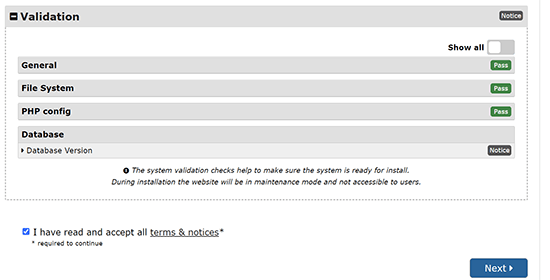
Dopodiché, fare clic sul pulsante “Avanti” per continuare.
Duplicator importerà ora il backup del database di WordPress dall’archivio al nuovo database.
Inoltre, aggiorna gli URL che puntano al sito locale e al nuovo sito live.
A questo punto è possibile fare clic sul pulsante “Admin Login” per accedere all’area di amministrazione di WordPress del sito live.

Una volta effettuato l’accesso al sito live, Duplicator pulirà automaticamente i file di installazione.
È tutto. Avete spostato con successo WordPress dal server locale al vostro sito live.
Metodo 2: Trasferire manualmente WordPress dal server locale al sito live
In questo metodo, vi mostreremo come spostare manualmente WordPress dal server locale al vostro sito live. Sarà utile se il primo metodo non funziona o se preferite farlo manualmente.
Passo 1: Esportare il database locale di WordPress
La prima cosa da fare è esportare il database locale di WordPress. Per farlo, utilizzeremo phpMyAdmin.
Se non lo conoscete, potete dare un’occhiata alla nostra guida alla gestione del database di WordPress con phpMyAdmin.
Basta andare su http://localhost/phpmyadmin/ e cliccare sul database di WordPress. Quindi, fare clic sul pulsante “Esporta” nella barra dei menu in alto.

Nell’opzione “Metodo di esportazione:” si può scegliere “Rapido” o “Personalizzato”. Personalizzato vi fornirà più opzioni per esportare il vostro database.
Tuttavia, si consiglia di scegliere “Rapido” e di fare clic sul pulsante “Vai” per scaricare il database.

Passo 2: caricare i file di WordPress sul sito live
Ora è necessario spostare tutti i file del sito web sul sito live.
Per iniziare, aprite il vostro client FTP e collegatevi al vostro account di hosting web.
Una volta collegati al sito live, assicuratevi di caricare i file nella directory giusta. Ad esempio, se si vuole che il sito sia ospitato su “yoursite.com”, si dovranno caricare tutti i file nella directory public_html.
Ora selezionate i file locali di WordPress e caricateli sul vostro server live.
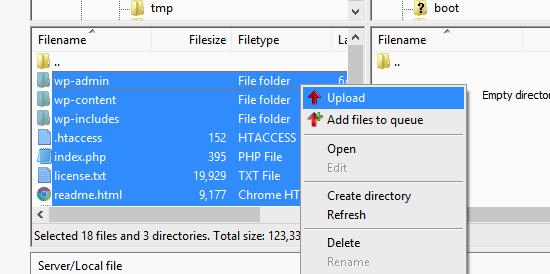
Passo 3: Creare un database MySQL sul sito live
Mentre il client FTP carica i file di WordPress, potete iniziare a importare il database sul server live.
La maggior parte dei fornitori di hosting WordPress offre cPanel per gestire il vostro account, quindi vi mostreremo come creare un database utilizzando cPanel.
Per prima cosa, è necessario accedere alla dashboard di cPanel e fare clic sull’icona “MySQL Database Wizard”, che si trova nella sezione “Database”.

Nella schermata successiva è possibile creare un nuovo database.
È necessario indicare un nome per il database, quindi fare clic su “Crea database”.

cPanel creerà automaticamente un nuovo database.
Successivamente, è necessario inserire un nome utente e una password per il nuovo utente e fare clic su “Crea utente”.
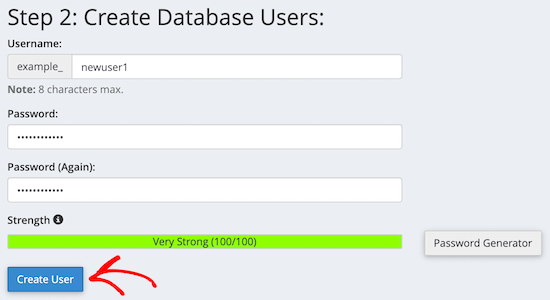
Successivamente, è necessario aggiungere l’utente appena creato al database.
Innanzitutto, selezionare la casella di controllo “Tutti i privilegi”.
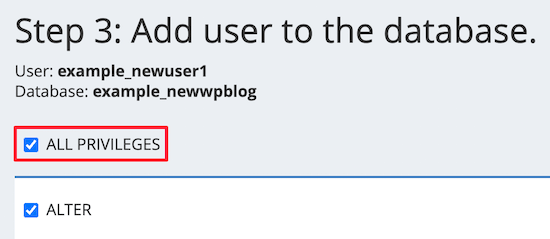
Quindi, scorrere verso il basso e fare clic su “Applica modifiche” per salvare le modifiche.
Avete creato con successo un nuovo database per il vostro sito WordPress live.
Passo 4: Importare il database di WordPress nel sito live
La fase successiva del processo consiste nell’importare il database di WordPress.
Andate nella vostra Bacheca cPanel, scorrete giù fino alla sezione “Database” e fate clic su “phpMyAdmin”.
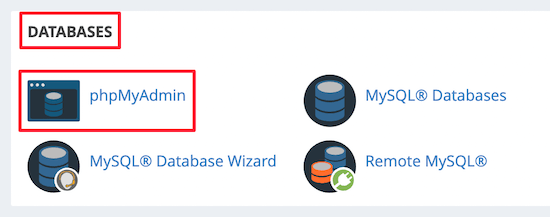
Si accede così a phpMyAdmin, dove si deve fare clic sul database appena creato. phpMyAdmin mostrerà il nuovo database senza tabelle.
Quindi, fare clic sulla scheda “Importa” nel menu superiore. Nella pagina di importazione, fare clic sul pulsante “Scegli file” e selezionare il file del database dal sito locale salvato nel primo passaggio.
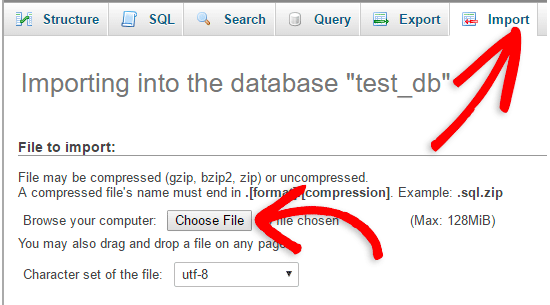
Dopodiché, fare clic sul pulsante “Vai” in fondo alla pagina. Il database verrà importato automaticamente in phpMyadmin.
Passo 5: modificare l’URL del sito
A questo punto, è necessario modificare l’URL del sito nel database in modo che si connetta con il sito WordPress attivo.
In phpMyAdmin, cercate la tabella wp_options nel database che avete appena importato.
Se si è cambiato il prefisso del database, invece di wp_options, potrebbe essere {nuovo_prefisso}_options.
Quindi, fare clic sul pulsante “Sfoglia” accanto a wp_options. Oppure, fate clic sul link nella barra laterale per aprire la pagina con l’elenco dei campi della tabella wp_options.
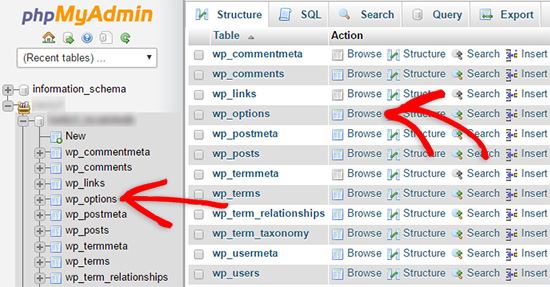
Quindi, nella colonna options_name, occorre cercare l’opzione siteurl.
Quindi, fare clic sull’icona “Modifica”.

Si apre una finestra in cui è possibile modificare il campo.
Nell’input boxed option_value, verrà visualizzato l’URL dell’installazione locale, che sarà qualcosa come http://localhost/test.
In questo campo è necessario inserire l’URL del nuovo sito, ad esempio: https://www.wpbeginner.com.
Quindi, è possibile salvare il campo facendo clic sul pulsante “Vai”.
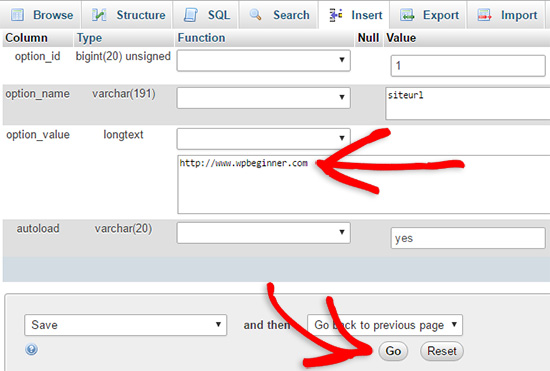
Successivamente, è necessario seguire la stessa procedura descritta sopra per il nome dell’opzione home. Il menu wp_options può essere lungo alcune pagine. Di solito, l’opzione home si trova nella seconda pagina.
Quindi, aggiornare l’URL della home, in modo che sia uguale a quello del sito live.
Passo 6: Configurare il sito live
Ora che avete importato il database e caricato i contenuti, è il momento di configurare WordPress.
A questo punto, il sito dovrebbe mostrare l’errore“Errore nello stabilire una connessione al database“.
Per risolvere il problema, collegarsi al sito web con un client FTP e aprire il file wp-config.php.
Dovrete cercare le seguenti righe di codice:
1 2 3 4 5 6 7 8 9 | // ** MySQL settings - You can get this info from your web host ** ///** The name of the database for WordPress */define( 'DB_NAME', 'database_name_here' );/** MySQL database username */define( 'DB_USER', 'username_here' );/** MySQL database password */define( 'DB_PASSWORD', 'password_here' );/** MySQL hostname */define( 'DB_HOST', 'localhost' ); |
È necessario fornire il nome del database, il nome utente e la password creati in precedenza.
Quindi, salvate il file wp-config.php e caricatelo sul vostro server di hosting WordPress.
Ora, quando si visita il sito web, questo dovrebbe essere attivo.
Dopodiché, è necessario accedere al pannello di amministrazione di WordPress e andare in Impostazioni ” Generale”. Quindi, senza modificare nulla, scorrere fino in fondo e fare clic sul pulsante “Salva modifiche”.
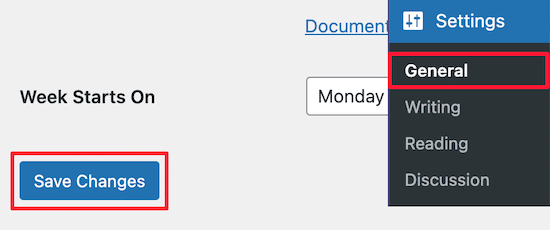
In questo modo ci si assicurerà che l’URL del sito sia corretto ovunque sia necessario.
Una volta fatto, andare su Impostazioni ” Permalinks, quindi scorrere verso il basso e fare clic su “Salva modifiche” per assicurarsi che tutti i link ai post funzionino correttamente.

Passo 7: Correggere le immagini e i link rotti aggiornando i percorsi
Ogni volta che spostate un sito WordPress da un dominio a un altro o da un server locale a un sito live, vi troverete di fronte a collegamenti interrotti e immagini mancanti.
Vi mostriamo due modi per aggiornare gli URL. Potete scegliere quello più adatto a voi.
1. Aggiornare gli URL con il plugin Search & Replace Everything (consigliato)
Il modo più sicuro per correggere questo problema è utilizzare Search & Replace Everything. Si tratta di un potente plugin per WordPress che consente di eseguire facilmente operazioni di aggiornamento di massa sul vostro sito web senza scrivere complesse query al database.
Per prima cosa, è necessario installare e attivare il plugin Search & Replace Everything.
Dopo l’attivazione, andare alla pagina Strumenti ” WP Search & Replace.
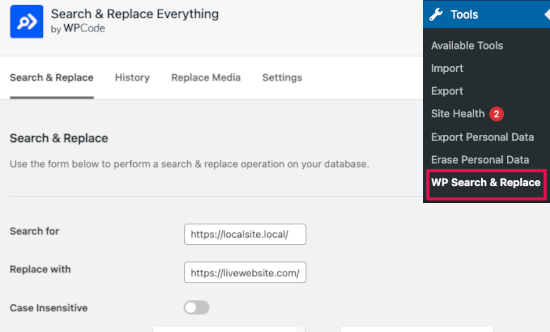
Da qui è necessario inserire l’URL del sito locale nel campo “Cerca” e l’URL del sito live nel campo “Sostituisci con”.
Scorrere un po’ e fare clic su “Seleziona tutto” sotto le tabelle. In questo modo il plugin cercherà il vecchio URL ovunque nel database.

Ora fate clic sul pulsante “Anteprima di ricerca e sostituzione” per continuare.
Il plugin cercherà nel database tutte le istanze del vecchio URL e vedrà l’anteprima dei risultati.
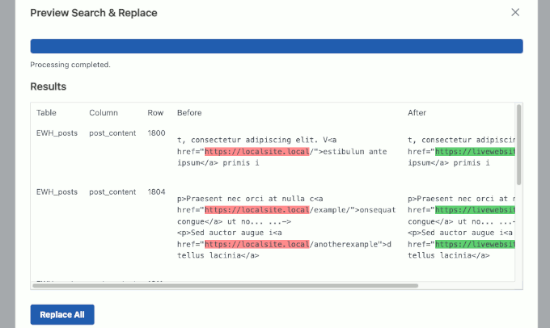
Se tutto sembra a posto, cliccate su “Sostituisci tutto” per salvare le modifiche.
Verrà visualizzata un’attenzione alle modifiche che si stanno apportando. Fare clic su “Sì” per continuare.
Il plugin aggiorna il database e sostituisce gli URL locali con l’URL attuale del sito web.
2. Aggiornare manualmente gli URL (avanzato)
Un altro modo per aggiornare gli URL è utilizzare la seguente query SQL:
1 | UPDATE wp_posts SET post_content = REPLACE(post_content, 'localhost/test/', 'www.yourlivesite.com/'); |
Basta andare su phpMyAdmin, fare clic sul database, quindi cliccare su “SQL” dal menu in alto e aggiungere la query di cui sopra.
Assicurarsi di modificare gli URL del sito locale e del sito live e fare clic sul pulsante “Vai”.
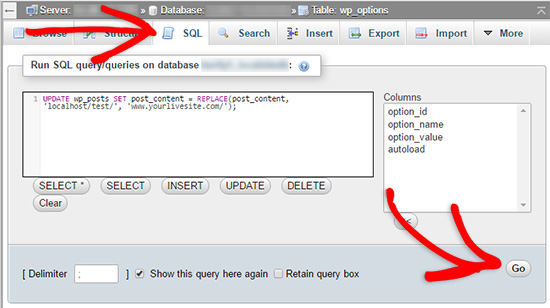
Ecco fatto. Ora avete migrato con successo WordPress dal vostro server locale a un sito live.
Speriamo che il vostro sito web sia attivo e funzionante senza problemi. Se notate degli errori, potete selezionare la nostra guida agli errori comuni di WordPress per aiutarvi nella risoluzione dei problemi.
Speriamo che questo articolo vi abbia aiutato a spostare WordPress da un server locale a un sito live. Potreste anche consultare la nostra guida sullo spostamento di un sito live su un server locale o dare un’occhiata alla lista di controllo definitiva per la migrazione di un sito web per i passaggi pratici della migrazione di WordPress.
Se questo articolo vi è piaciuto, iscrivetevi al nostro canale YouTube per le esercitazioni video su WordPress. Potete trovarci anche su Twitter e Facebook.





Axel
I love this entry, I use it as a checklist every time I make a migration.
WPBeginner Support
Hey Axel,
Glad you find it useful Don’t forget to join us on Twitter for more WordPress tips and tutorials.
Don’t forget to join us on Twitter for more WordPress tips and tutorials.
Admin
Gary
I keep getting stopped at step 4. when I import my datatbase I get the following error
#1231 – Variable ‘character_set_client’ can’t be set to the value of ‘NULL’
I only have limited sql knowledge and never done anything like this before. any help/guidance would be greatly appreciated
Andrew
Hello,
So I got to step 6 without any issues until my website failing to become live. I went into my wordpress general setting and my site url was still a localhost. Am I suppose to change the site url before I upload it into the ftp program and into my host, or can i leave that as localhost? Or, do i change the site url in wordpress after i’ve uploaded my files into my hosting site?
This page was super helpful, thanks!
Daneesh
Hi. Thanks so much for this, excellent tutorial. I seem to have got stopped at Step 6. I am still getting a “Error establishing database connection” error. DO i need to change the hostname field in the config.php too? and what do i change that to?
Simon
Amazing, it worked, thank you.
sornanun
Thank you very much.
Annete Momanyi
Thank you for the article. I have managed to sort my problem after following these steps.
Arash
Hello there,
I have two questions and I’d be grateful if you could help me!
1) Why do I have two ht-docs and wp-content folders inside my WordPress folder?
2) When I move my WordPress website from a localhost to the live host, It’s possible to remove my localhost or should I keep it forever?
Thanks in advance!
Matze
1) By installing WordPress on your hosted server, these docs/folders will be automatically added. I think while uploading your files from local to live via FTP __ht-docs__ and __wp-content__ just weren’t replaced.
But please check your local files which are normally located in the WAMP/MAMP folders unter __htdocs__ . Are there also two copies of the datas? Then you should find out, which one is the right one …
2) At the time uploading your files from local to live, the local datas are a backup. After some weeks, changing and editing your live site on the server you can delete the locals.
But you should create a backup regular and store the datas local (Quote: “If you are doing this on a regular basis, then we highly recommend that you get BackupBuddy because it will make your life easy. You will thank us for that later”)!
Hope it helps
Starfleet Nnaemeka
Wow! What a wonderful tutorial , seriously i really appreciate the effort you guys brought out to write these tutorial. Thanks it really helped me to set up my website build on wordpress from localhost on wampserver.
Leo Laroche
i have followed all the steps, but when i type in my website the old website comes up. Can someone help me please.
rachel asakome
i have followed steps 1-5, but i am not sure where my site is. sorry it sounds really dumb but i am not great with technology. I have uploaded the files, but when i type in my website the old website comes up
Justas
server DNS address could not be found.
ERR_NAME_NOT_RESOLVED
I changed everything accordingly, but still can’t connect.
Carrie
Could you please explain on how to do this with webmatrix? I have a PC and my wordpress install on my local PC was with webmatrix. I do not have a MAC. Where on webmatrix do I export? I am confused about this. Also, you have create a db in cpanel my sql. Where do I save this new db? On the cpanel someplace or on my local pc hard drive and under what name? I have a domain with go daddy and a web hosting I purchased. They said to do a brand new fresh install of wordpress from there site…. why would I do this? I already have my wordpress via webmatrix on my local pc this is where the website I built resides. How do I get this on my web hosting? Confused on the db stuff and how to get my local wp files/db to my web host. Thank you.
Neo An
Very clear!
Thank you very much!
Milica
This is a great tutorial. Thanks a lot!
Amber
I have followed all of these steps and when I view my site it is showing my content like words and links but none of the decorative stuff or plugins etc. My menus are showing up as just a list of words as if I created a page without any real CSS. My CSS files are not missing so I do not know where the mess up is happening. I tried to do the part about fixing broken links and I am not 100% of what I should put after the localhost part. I used the name of the folder that my entire wordpress database/files/etc are in. I cannot seam to figure out what is going wrong.
Abdul
@AMBER and all those struggling with the same issue, the problem with the deployment process of WordPress’ database is due to the empirical replacement of your local URI with the live site’s URI as explained in this article at Step 7. If you just execute the UPDATE SQL statement as shown, you, most of the time, end up corrupting your database. Why? The reason is simple: WordPress has a way of serializing some metadata for its own convenience. This post explains it pretty well: nacin.com/2010/04/18/wordpress-serializing-data
If you look at this array:
array( ‘apple’, ‘banana’, ‘orange’ ),
when serialized it looks like this:
a:3:{i:0;s:5:”apple”;i:1;s:6:”banana”;i:2;s:6:”orange”;},
where:
– a:3 stands for “array of size 3”
– i:0; i:1; i:2 stand for “integer index 0; integer index 1; integer index 2″ respectively
– s:5:”apple” stands for “string, length 5, data=apple”
– s:6:”banana” stands for “string, length 6, data=banana”, etc.
As you can see, any serialized string is stored along with information about it’s length. So when you do a simple search and replace in your tables, all occurrences will be replaced indeed but the string’s length metadata won’t.
In the case your local URL’s length equals your live site’s URL length, then you’re lucky; if they don’t match then you’re in trouble.
The question now is: “How do I fix this?”. I’m happy to say that, fortunately, there are many plugins that can help you with this but one that’s really simple and good at it is “Better Search Replace”.
Simply install this plugin in your local WordPress installation and proceed as explained in this article. The only place where you can safely replace your local URL is in the wp_options table as explained at Step 5.
Once you’re done installing the plugin, in the admin panel, go to “Tools, Better Search Replace”, in the “Search” text box type your local site’s URL (e.g. http://localhost:12345) and in the “Replace with” text box, type your live site’s URL (e.g. http://www.example.com) and you should be ready to go. Just make sure you don’t include any trailing forward slash “/” in the URL (at the end like http://localhost:12345/ or http://www.example.com/)
I hope this explanation was useful and please let me know if it helped.
Happy coding!
Simon
Hi,
Brilliant article and very easy to follow.
However, as a WordPress virgin I am struggling with the whole concept of having a separate database from the website. I have created everything locally on my PC. But the local PHP Admin will allow me to use however many characters i like in naming my database but my remote server/host (123-reg) will only allow 9 (my original had 11) so…. the database name locally is different from the database name remotely. I have exported the database tables and imported them in to the remote database, renamed my wp-config to point to the new shorter database name with the correct user name and password but i am still getting the ‘Error establishing a database connection’
message. Any suggestions?
Could the fact that the tables are exported from a database with a different name from the one they are being imported to make a difference?
Gabriel
Hello I made all of your steps but I can see only a white page. It doesn’t notify me an error.
I upload everything in a subdirectory of my website. It’s because of that? Is there a solution?
Patrick Hasch
Great article, if the upload of zipped files doesn’t work try uploading .sql files instead.
Tony
I also faced the same problem.
John James
Hello. From your step 6, you said we should change database name, user and password. Are we supposed to change the hostname too?
WPBeginner Support
See step 3 to find out your hostname and use that instead.
Admin
John
Step 3 says nothing about host names.
WPBeginner Support
When you are creating a database on your webhost, you will be able to see the hostname. If you don’t then this means you are using localhost.
Mohd Hasan
i followed all steps but going to install.php page , someone can help me , i really need your help
Gabor
Hello!
i have 500 internal error on server.
I think the problem is with .htaccess.
Can u help in this?
Dawn
I am having this same issue. I followed every step exactly, I fixed the wp-config.php file and re-uploaded it, but now when I go to my live site it says,
“This page isn’t working
[my site] is currently unable to handle this request.
HTTP ERROR 500”
Dawn
I should have said that that is the error I get when I try to go to my wp-admin. When I go to the site itself it’s blank.
Axel
The solution for image references is to execute the following scripts on your DB:
(I can’t write the real scripts because wpbeginner.com thinks I’m doing SQL injection :\ )
UPDATE wp_posts to set the value of column guid to the value of function REPLACE(guid, ‘http://old.site.url’, ‘http://new.site.url’)
AND
UPDATE wp_postmeta to SET the value of column meta_value to the value of function REPLACE(meta_value, ‘http://old.site.url’, ‘http://new.site.url’)
Also don’t forget to check permissions for wp-content/uploads to ensure you can add more images.
Aimy
Hi,
Thanks for this. I did everything as you described. It seemed that everything went well apart the front page that shows nothing but just the navigation menu.
When I go to the page builder of the front page it shows that there is nothing added there.
Any advice?
Krishna
Dear wpbeginner owner
Its working for me !
thank you very much!
Philippe
Damn I’m so lucky wpbeginner exists, I’ve finally managed to get my website to work thanks to this post, I had to fight my way trough (there is an older database-version on my webhosts server) but I did it thanks to you guys!
Umai Hassan
URL Changing
I have changed the URL in wp_option table but only home page loads correctly other pages links are still set to localhost/something ??
What should I do to change all links??
Cos
Brilliant article – thanks! Got through the process without a hitch first-off :-)))
Dan Odaka
Hey, after doing all that, when I go to my site I get a page that shows me the index of wordpress and not my site. what do I do?
WPBeginner Support
This could happen due to an incomplete file transfer. Try to upload your WordPress files again.
Admin
Sonja
Hi. thank you very much for this post. It seems to be very helpful and I’ve tried to follow every step, but now that I’m done, when I go to my URL I get a “Server not found” error (The host shows me a preview with “under-construction” and their logo, which was online before I uploaded the data and database – shouldn’t I at least get that?). Do you have any ideas where I might have gone wrong, and is it best to delete everything and start again from scratch, or overwrite it, or look for any particular errors?
Thank you for any help!
WPBeginner Support
You may have installed WordPress outside your public directory.
Admin
Hugues Pinsonneault
im wondering if you have any recommendation for developing locally new functionalities on a local dev install, while the client can still do updates on the real database.
shah
Hi
Thankyou for the details, but i am still not able to get the path of images correct inspite of the changes done … i have my folders in public_html and have my db created …my live website is working fine except for the pic / logos
zarna
My wordpress site went live but my images are not getting replicated and they aren’t visible. Can you please guide me what should be the images folder structure while uploading it to live ??
Your help and guidance would be appreciable.. Thank you.
Coil McCoy
Great post !!!
Only the last part doesn’t worked for me, the pictures and links still missing !
Any clue?
thank you
Vinish Chaudhary
Hello,
All great beside this You don’t have permission to access / on this server.Don’t know why it is showing when I try to access my site.I have done all steps like you said but getting this error can anyone please help me to solve this problem.
Sudais
Instead of this long way,I use a plugin called wp all in one migration,I just need to import a single file using a plugin when I go live and all done,no playing with databases,etc.I think everyone should do that saves alot of time and handywork.
hiren
can u put the demo ..
thanks.
hiren patel.
Paul
Great article ! But I’m still stuck at the last step. Images aren’t showing on my website.
Well in fact they does, but only on my PC. Everybody else is getting a buggy website.
Farooq Bashir
Wow .. Great Article sir
Its Perfect Working.
Thanks
Bikram Ray
Hi,
No doubt; a very useful article. But I got stuck in the last step. I ran the SQL update query but still having issues regarding image path.
Just one thing; while uploading the file through FTP, I did not upload the wordpress folder (the test folder) rather I uploaded whatever inside it.. So in the server there is only the folders and files directly placed under ‘public_html ‘
Regards,
Bikram
Kay
DIDN’T WORK!!
Error
SQL query:
—
— Database: `wordpress`
—
CREATE DATABASE IF NOT EXISTS `wordpress` DEFAULT CHARACTER SET utf8 COLLATE utf8_general_ci;
MySQL said: Documentation
#1044 – Access denied for user ‘ksalim’@’localhost’ to database ‘wordpress’
WPBeginner Support
Please check your database name, mysql username and password.
Admin
Damilola
A very awesome article, it really made a project i was working on for a client already on my local machine easy to move to his server, i mean i literally tried to develop the website all over again and it was such a pain in the ass….Thank you
WPBeginner Support
Glad you found it helpful. Don’t forget to join us on Facebook for more WordPress tips and tutorials.
Admin
Tim Vincent
Thank you so much for this guide. I struggled doing this for some time before finding this. I followed it word for word and all seems to work. I am very grateful!
WPBeginner Support
We are glad you found it helpful. Don’ forget to follow us on Twitter for more WordPress tips and tutorials.
Admin
sonu
hello! syed
i want to ask you to from where i get the best free wordpress simple attractive theme which laterly i planned to upload on the live server….any help would be much appreciated….thanks…
WPBeginner Support
See our list of 37 simple WordPress themes you should try.
Admin
sonu
hello! syed
i want to ask you when we upload the worpress site from locahost to live server….i just want to ask the wordpress having lot of files and inside the wp-content/themes/… having three different types of theme like twenty fourteen,twenty thirteen ,so is it needed to upload all these themes or not….help would be much appreciated…..thnks…..
Ridhik
No,u just upload the theme folder that currently activated in your site.
Andres Paz Soldan
Thank you! This was very useful!
WPBeginner Support
Hi Andres, glad you found it useful.
Admin
Lellys
First of, thank you!
I did everything and my site is working, but when I need to login on my wp-admin, it show me a blank screen and nothing happens. Any idea?
paddy lutaaya
thank you for this article i have followed the steps and uploaded my website to c panel but it has failed to work it brings internal error please help me solve this thank you
WPBeginner Support
Please see our guide on how to fix internal server error in WordPress.
Admin
Phillip Pilkington
Allgreat advise except step 6. I have not got past this stage, the advice is not clear. My website shows the Error Establishing Database Connection. This next part doesn’t explain anything to me.
“To fix this, connect to your website using an FTP client and edit wp-config.php file. Provide the database name, user and password you created earlier in Step 3. Save the wp-config.php file and upload it back to your server. Visit your website, and it should be live now. ”
I am connect via ftp, then just edit the file….no, nothing happens from here.I open the file in aneditor but I don’t make any changes because it does not show anything about whatis expalined.
Regards,
Tyler Hall
Hey, I am currently transferring the files as we speak. Not sure if you found a solution yet (hopefully you have its been 15 days) but you should probably change the hostname: /** MySQL hostname */
define(‘DB_HOST’, ‘ ‘ your hostname before should have been your localhost or similar.
Himanshu
Thanks for the post. Really helped solve my problem. Although I faced some issues with database importing. After much effort, updating the phpmyadmin version fixed it for me. If possible you could also include common errors in each section, so that a beginner doesn’t get lost. As it happens, most likely you are going to face some error here and there. Other than that great post. Thanks.
WPBeginner Support
@Himanshu Thanks for the Feedback, we really appreciate it.
Admin
Ola
Hi,
Thanks for this, the steps are so direct and you made WordPress uploading fun.
Andy
Hi. When I go to my website it says Welcome to: yourwebsite.com
This Web page is parked for FREE, courtesy of GoDaddy.com. Do I have to register my domain? I just thought of a random website name to put in for the changing site url step 5. Also when I enter the local host site I get the message the webpage could not be found. What should I do?